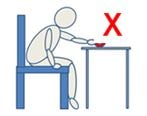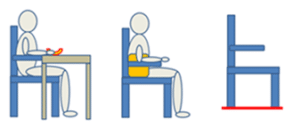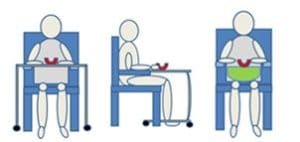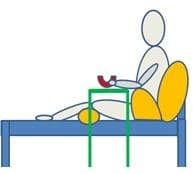Taking Care When Eating and Drinking
Click here to print the Taking Care when Eating and Drinking guide
A balanced diet and good hydration are important for general health and mobility.
To eat and drink independently, and safely a person should be seated in a supported upright position so that they can swallow safely when eating and drinking and also be close enough to the food and drink to use the cutlery to scoop and lift the food to their mouth. Supporting yourself to stay upright to eat and drink in bed or sitting on a soft chair takes a lot of effort.
If you have to lean forwards or to the side to reach food this position will make swallowing and digesting food more difficult.
If a person is unable to swallow safely or has difficulty with digestion; consult their GP or Speech Therapist for advice.
Find a safe and stable position for eating and drinking
Use a dining chair with arms, pulled close to the table, for a supported upright position when eating and drinking. A cushion tucked on each side and held in place by the armrest will give extra stability when eating and drinking. Chairs can have ‘skids’ or sliders fitted to help move the chair closer to the table.
If the person eats and drinks in an armchair, an over-chair table with legs that span the width of the chair will help get the food as close as possible to the person when eating, so they avoid leaning forward to reach the food. If using a cantilever table, get it as close as possible by sliding the base under the chair from the side or the front of the chair. A bean bag lap tray may keep a cup and plate closer when eating and drinking.
Sitting in a wheelchair at a table for meals can be made more comfortable with adjustments to the armrests and footrests to get the wheelchair as close as possible to the table. If this isn’t possible then try a wheelchair tray, a cantilever table, or a bean bag tray.
When eating and drinking in bed; Help safe swallow by sitting upright with pillows or a backrest and a pillow and under the knees for support. Use an over-bed table or a tray positioned as close as possible to avoid to need to lean forwards. Some profiling beds can be adjusted into a chair-like position when eating and drinking in bed.
Choosing cutlery, plates, and cups for safe eating and drinking
When the person is seated in a supported position, as described over the page, they can then use their strength and movement to eat and drink more safely and independently. A careful choice of plates, cups, and cutlery can also help to make eating and drinking easier.
You can call our team to find out more about this equipment.
If the person has a tremor, weakness, or reduced movement;
- A non-slip mat will help to stabilise a cup and plate on the tray or table.
- A plate with a raised edge, like a pasta dish, may help when scooping food.
- A plate guard can be clipped onto a plate to give a raised edge to help with scooping.
- Padding can be added to cutlery to make it easier to grip.
- A ‘spork’ is a mixture of a fork and spoon which can be easier if using one hand to eat.
- A rocker knife can be used with one hand to cut food with a rocking action.
- A cutlery strap can hold cutlery securely without the need to grip when eating.
- Spoons with an angled handle help to reach the mouth if movement is restricted.
- Scoop spoons help to keep the food on the spoon when there is a tremor.
- Weighted cutlery may help when there is a tremor.
- Mobile arm supports can help when scooping and lifting food to the mouth.
- Powered-eating devices are available to enable a person to eat independently.
- Cups with a lid or a non-spill insert can help if tremor is causing spills.
- Avoid cups with spouts as these may affect safe swallow or cause a gag reflex.
- Cups fitted with a sipping lid to let the liquid flow into the front of the mouth are safer.
When holding or tipping a cup is difficult;
- Insulated cups with large handles are easier to hold, some have 2 handles.
- Extra clip-on handles can be used to fit onto your mug, cup, or glass.
- A small cone-shaped cup can help if head movement is restricted when drinking.
- There are cups with a cut-away side, for drinking without the need to tip the head back.
- Some straws have a one-way valve to reduce the amount of suck needed.
- Clips and spill-proof lids can be used to keep the straw in place.
- Hydration bottles with flexi straws can be fixed for easy access from the bed or wheelchair.
- Avoid cups with spouts as these may affect safe swallow or cause a gag reflex.
When eating and drinking is affected by difficulty with understanding or orientation;
- Familiar cutlery, plates, and cups help to remind a person about how to eat and drink.
- Avoid patterned plates, as food can be lost or unrecognised in the pattern.
- Avoid patterned table cloths as plates can be lost on the patterned surface.
- Choose manageable, familiar food so the person can use retained skills at mealtimes.
- If cutlery is no longer manageable, consider food that can be eaten without cutlery.
- Alerts can be set on phones, tablets, and via apps to remind a person to eat and drink.
We have equipment for eating and drinking at our assessment centre and can advise on solutions and local suppliers. Call our team for advice and information.



